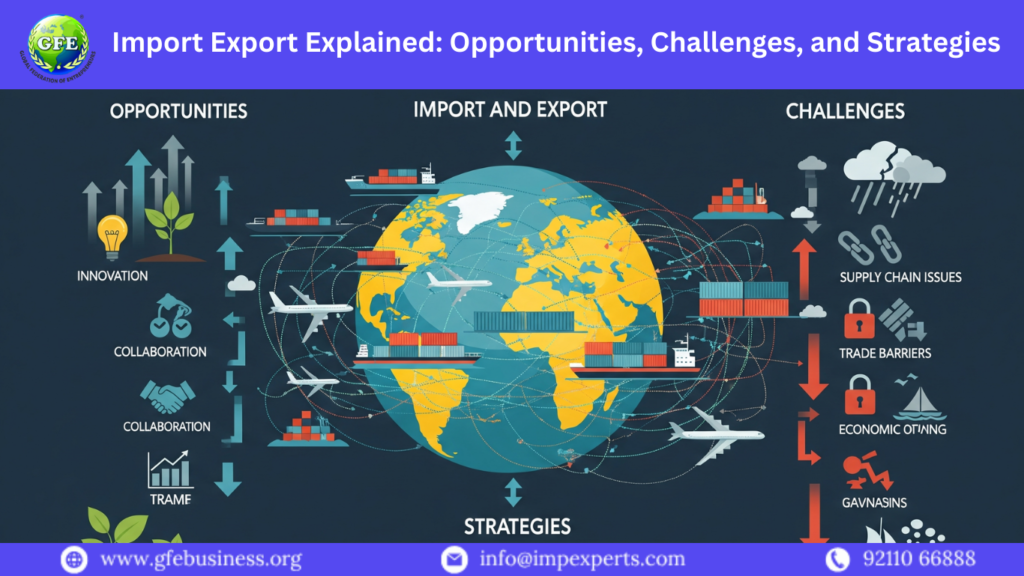If you are planning to step into the world of international trade, understanding import export is crucial. Importing and exporting products is not just about sending or receiving goods across borders; it involves compliance, market research, logistics, financial planning, and global networking. For Indian entrepreneurs, students, and small business owners, import export presents a huge opportunity to expand business horizons and earn from international markets.
Many traders and aspiring exporters turn to professional platforms like GFE Business to gain practical training, understand compliance requirements, and avoid costly mistakes that beginners often make.
In this guide, we’ll explore the fundamentals of import export, the opportunities it offers, the challenges you might face, and strategies for succeeding in the global market.
What is Import Export?
Import export refers to the buying (import) and selling (export) of goods and services across international borders.
- Importing is when you bring goods or services from another country into India for resale or consumption.
- Exporting is sending goods or services from India to foreign markets.
The process is more than just shipping products; it involves legal documentation, currency management, logistics, customs clearance, and understanding international trade regulations.
By engaging in import export, businesses not only generate revenue but also contribute to the country’s foreign exchange and global trade footprint.
Why Import Export is Important
The import export sector is a vital part of the global economy. For Indian businesses, it allows:
- Access to international markets: Selling products abroad increases revenue potential.
- Competitive advantage: Importing raw materials at lower costs can improve margins.
- Business diversification: Reduces dependence on the domestic market.
- Brand recognition: Being present in international markets strengthens brand credibility.
For instance, India exports IT services, pharmaceuticals, and handicrafts, while importing electronics, machinery, and crude oil. This exchange creates jobs, encourages innovation, and supports economic growth.
Opportunities in Import Export
1. Access to Global Demand
Exporting allows businesses to tap into markets with higher demand and better pricing. Products that may be common in India, like spices or textiles, can fetch premium prices abroad.
2. Cost-Effective Sourcing
Importing products from countries with lower production costs reduces expenses. This is especially useful for manufacturers needing raw materials or components.
3. Government Support
The Indian government offers several incentives for exporters, such as duty exemptions, export promotion schemes, and financial support through DGFT. For more details, visit DGFT India.
4. High Profit Margins
Certain products like organic food, handicrafts, or specialized machinery have higher profitability in foreign markets.
Challenges in Import Export
1. Regulatory Compliance
Every country has its own set of regulations, and missing documentation can delay shipments or incur penalties.
2. Currency Fluctuations
Dealing with foreign currencies introduces risk. A sudden change in exchange rates can impact profits.
3. Logistics & Shipping
Transportation costs, delays, and port congestion can affect timely delivery.
4. Competition
Global trade involves competing with established international players, which can be challenging for newcomers.
Essential Import Export Documents
Proper documentation is the backbone of international trade. Some critical documents include:
- Commercial Invoice: Detailed bill of sale for customs clearance.
- Packing List: Describes the contents, dimensions, and weight of shipments.
- Bill of Lading (B/L) or Airway Bill (AWB): Proof of shipment and contract of carriage.
- Certificate of Origin (COO): Confirms the country of manufacturing.
- Import Export Code (IEC): Mandatory for legal import/export from India.
- Letter of Credit (LC): Bank guarantee ensuring payment.
- Insurance Certificate: Proof that goods are insured against transit risks.
For an in-depth guide, check GFE Business Import Export Documents Guide.
Strategies to Succeed in Import Export
1. Conduct Market Research
Understand which products are in demand abroad, the target countries, and competitor pricing. Resources like Export.gov can help.
2. Start Small
Begin with small shipments, learn the processes, and gradually scale operations.
3. Build a Network
Attend trade shows, join online B2B marketplaces, and network with suppliers and buyers. GFE Business also provides connections and professional guidance.
4. Leverage Technology
E-commerce platforms, CRM systems, and digital marketing can help reach international buyers efficiently.
5. Risk Management
Secure shipments with proper insurance, and hedge against currency risks through banks or financial instruments.
Import Export Training
Structured training is essential for beginners. Cities like Ahmedabad, Pune, Delhi, and Mumbai offer courses that cover:
- International trade compliance
- Documentation
- Logistics management
- Marketing strategies
- Government incentives
Courses from GFE Business provide real-world insights and practical exposure, preparing entrepreneurs for real trade challenges.
Case Study: Small Business Going Global
A textile manufacturer from Ahmedabad started locally. After completing an import export course from GFE Business, he began exporting to the Middle East. Within two years, exports accounted for 70% of revenue, showing how knowledge and strategy can transform business growth.
Final Thoughts
Import export is more than shipping goods—it’s about building a global business mindset. Understanding opportunities, overcoming challenges, and applying strategic practices can result in sustainable growth.
For beginners and business owners, taking professional training and guidance from experts ensures a smooth start in international trade.
📞 Want to learn how to start your import export business the right way?
Visit 👉 GFE Business and get expert-led training that prepares you for real-world trade.

